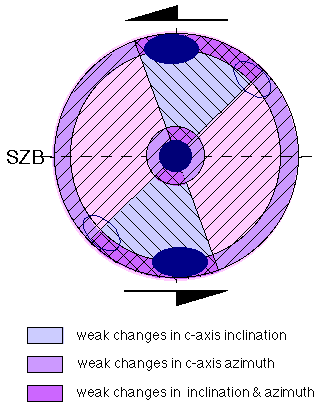
This pole figure outlines fields of relative c-axis orientational stability (low c-axis rotation rates). The boundaries of the stability fields derive directly from the angles corresponding to horizontal dashed lines that separate the differently sloped curves of the previous two diagrams.
C-axes of the not hatched field rotate quickly towards orientations with slower c-axis rotation rates before becoming eliminated by dynamic recrystallization. Thus, these grains have a relatively low survival potential in strain history.
Intersections of the left- and right-hatched fields correspond to c-axis orientations that are characterized by low azimuthal and inclinational rotation rates. Exactly these fields contain most of the c-axes of the cross girdles, single girdles and c-axis point maxima and reflect, therefore, c-axis orientations in which intracrystalline glide is favored (easy glide orientations). Additionally grains with c-axis positions within these high rotational stability fields show the highest survival potential in strain history.
The concentration of c-axes along a cross girdle in the low rotation fields and the fact that this c-axis cross girdle is symmetrically disposed with respect to the long axis of the finite strain ellipse implies that the crystal’s slip systems are in conjugate orientations with respect to the incremental stretching direction at the end of the first transient stage. Thus, the sample material preliminary accommodates strain with pure shear extension parallel to the incremental stretching direction by intracrystalline slip. With strain, however, one limb of the cross girdle becomes eliminated by a combination of grain elimination by grain boundary migration and low c-axis rotation rates resulting in a steady state single girdle or two stable c-axis point maxima. In these steady state textures the inferred basal planes are subparallel oriented to the SZB allowing intracrystalline gliding in a true simple shear mode.